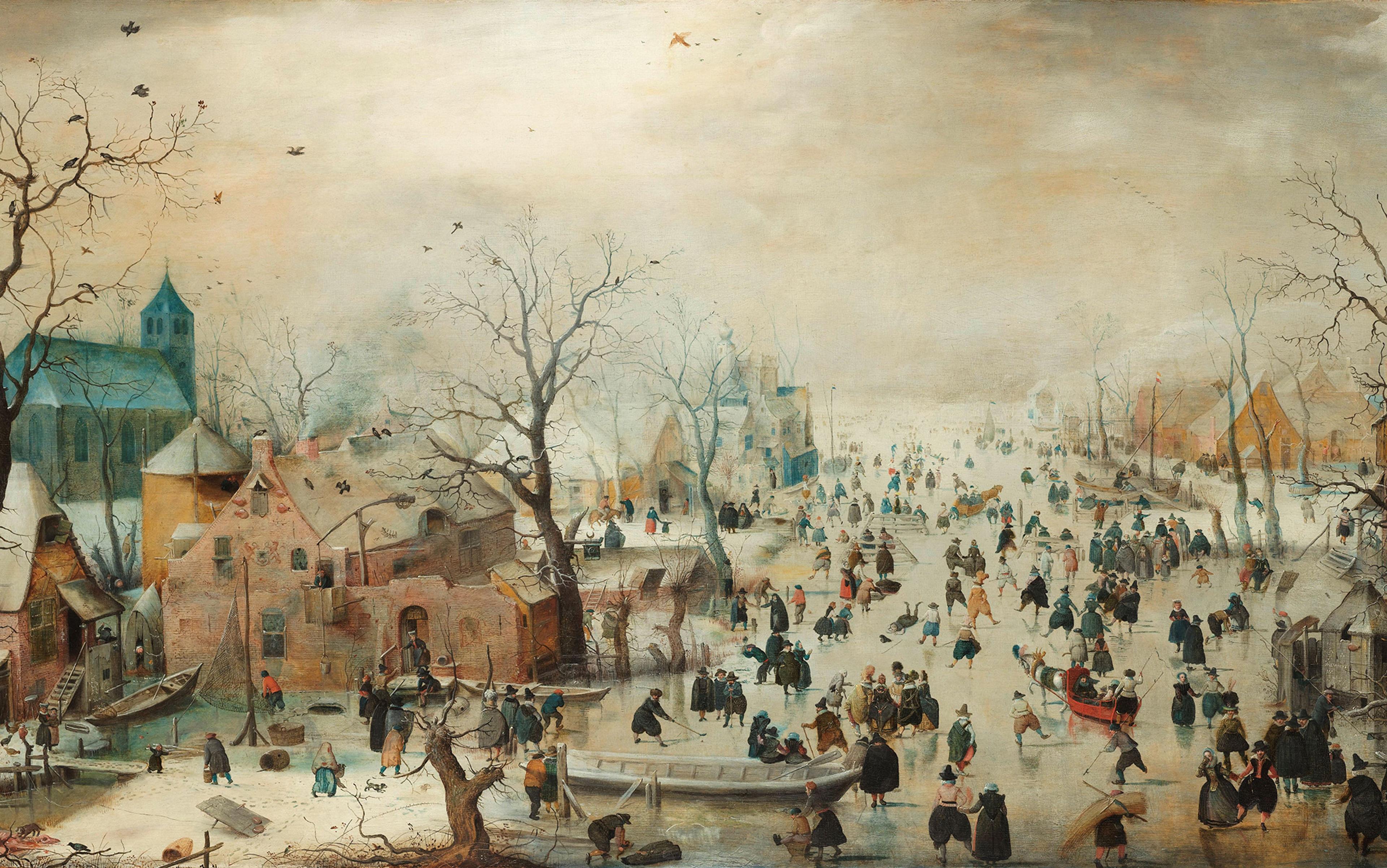Midway through the 17th century, Dutch whalers bound for the Arctic noticed that the climate was changing. For decades, they had waited for the retreat of sea ice in late spring, then pursued bowhead whales in bays off the Arctic Ocean islands of Jan Mayen and Spitsbergen. They had set up whaling stations and even towns in those bays, with ovens to boil blubber into oil. Europe’s growing population demanded oil for lighting and cooking, and for industrial purposes that included the manufacture of soap. Now, thick sea ice kept whalers from reaching their ovens even in mid-summer. Climate change, it seemed, had doomed their trade.
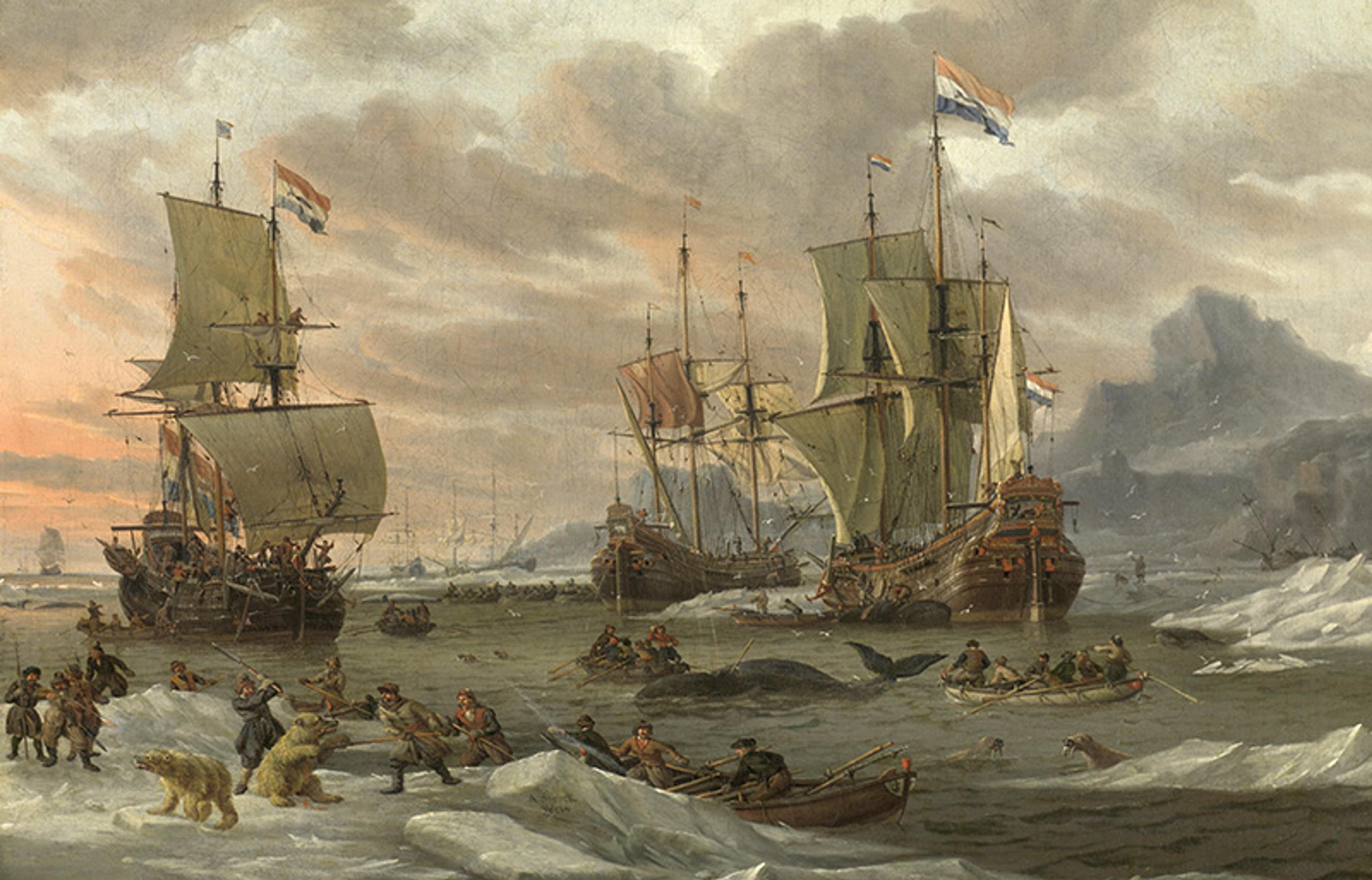
Whaling Grounds in the Arctic Ocean by Abraham Storck, 1654-1708. Courtesy the Rijksmuseum, Amsterdam
Yet in the frigid decades of the late-17th century, the Dutch whaling industry boomed. Whalers discovered how to boil blubber aboard their ships or on sea ice, then learned how to transport it from the Arctic to furnaces in Amsterdam. There, labourers boiled the oil until it reached a purity never achieved in the Arctic, giving Dutch whalers a competitive edge in the European market. Shipwrights greased and reinforced the hulls of whaling vessels so that they could slide off thick ice and survive the occasional collision. The governing council of the Dutch Republic – the country that would become the Netherlands of today – allowed a corporate monopoly on whaling to expire, and thereby encouraged competition between hundreds of new whalers. Ironically, by provoking crisis, climate change spurred a golden age for the Dutch whaling industry.
Many of us think of today’s extraordinarily rapid, human-caused climate change as an existential threat to humanity, one that will inevitably wipe away cities, industries, countries, perhaps even our species – or at least our way of life. Many historians, archaeologists and natural scientists have thought about the modest, natural climate changes that preceded the 20th century in much the same way: as existential threats to past civilisations. In their accounts, communities and societies wedded to old ways of life had little recourse when previously predictable weather patterns abruptly changed. Time and again, they argue, past climate changes provoked civilisational ‘collapse’: a sudden unravelling of social and economic complexity, culminating in a catastrophic decline in population. In popular books and articles, journalists and scientists draw on these ideas to argue that because natural climate changes destroyed past civilisations, anthropogenic warming could well doom ours.
Yet new research is telling us something very different. It is revealing that many – perhaps most – communities successfully endured past climate changes. Some bounced back quickly after severe and previously unusual weather; others avoided disaster entirely. Many adapted to become more resilient to damage, or to exploit new opportunities. Climate change in fact repeatedly altered environments so they better suited how some societies grew food, made money, or waged war.
Even in resilient societies, thousands died amid the most extreme weather unleashed by past climate changes. Yet it is becoming increasingly clear that our ancestors often acted decisively and creatively to make the best out of trying times. Far from an outlier, the story of Dutch whalers in the Arctic is merely one example in a history of ingenuity in the face of past climate change.
If you follow the weather, you will no doubt have heard that a day, month or year is the hottest on record. It might be tempting to assume that this record involves all of natural or at least human history, but it really refers only to the almost century-and-a-half in which weather stations equipped with accurate thermometers gradually spread across the world. For much of that period, human greenhouse gas emissions have been the driving force behind changes in Earth’s average annual temperature.
To determine just how unusual these global changes are, how they might transform local environments, and how they are linked to the changing chemistry of Earth’s atmosphere, researchers have searched far and wide for evidence of earlier climatic variability. By measuring the thickness of rings embedded in the trunks of trees, for example, they have traced how the growth rates of trees scattered around the Earth accelerated or slowed in past centuries. They have compared these fluctuating growth rates to recent, reliable records of temperature and precipitation, and thereby developed an understanding of how different trees respond to climatic trends. With that knowledge, they have used growth rings in living trees, fossilised wood and even timber embedded in ancient buildings to reconstruct changes in Earth’s climate from antiquity to the present.
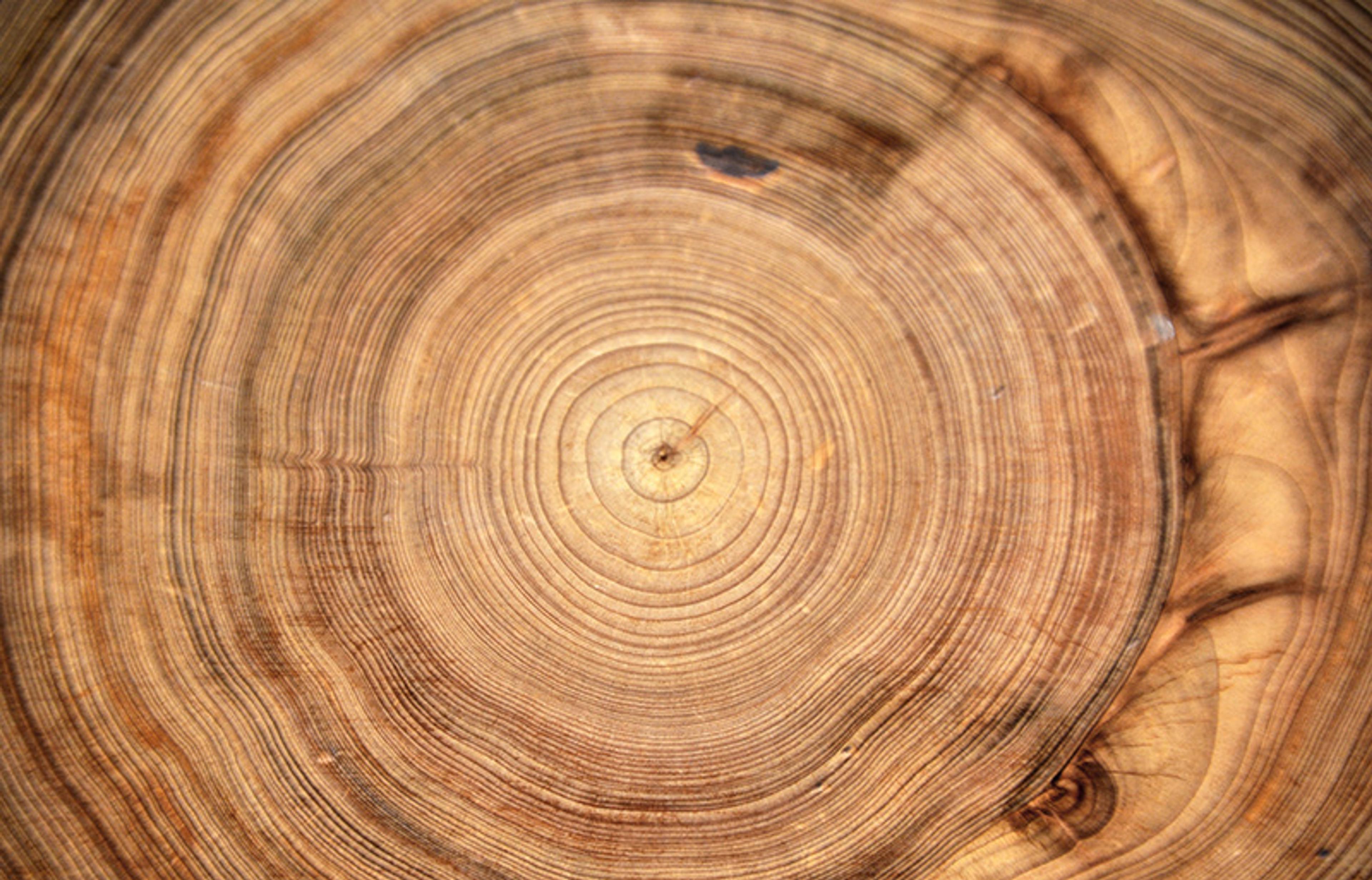
Tree rings in bald cypress (Taxodium distichum) wood. Photo by James St John/Flickr; licensed under CC BY 2.0
Other scientists have drilled deep into the ice sheets of Greenland and Antarctica, and exhumed long cylinders – ‘cores’ – of densely packed ice. The deepest ice in Antarctic cores might be millions of years old. Just as tree trunks are wound with growth rings, the cores are stacked with layers that register the annual accumulation of snow. By comparing the shifting ratios of oxygen and hydrogen isotopes in these layers, scientists learn how precipitation patterns have fluctuated around the poles, which in turn reveals much about the history of Earth’s average annual temperature. Bubbles trapped in cores even contain tiny samples of the ancient atmosphere that, when carefully measured, reveal historic changes in the atmospheric concentration of carbon dioxide and other gases.
Climate ‘proxy’ sources such as tree rings or ice cores register the influence of past climate change. They do not directly record it as a thermometer might. Their ‘resolution’ – a word that could be roughly defined as their precision in time and space – might be quite low, and each source tends to work best for a particular period or place. Historians have learned to help scientists fill some of the gaps by using archaeological, textual or oral records of past weather. Perhaps the most abundant and most useful are logbooks written by European sailors in the age of sail. Because sailors had to keep track of the wind in order to navigate when out of sight of the coast, logbooks contain rich records of daily or even hourly weather.
Under the scrutiny of historians and scientists, Earth’s past climate has gradually and grudgingly divulged its secrets, one imperfect source at a time. It turns out that our planet is a volatile place, with a climate that never stops changing.
Global cooling in even the chilliest decades probably did not exceed 0.5 degrees Celsius
Midway through the 13th century, for example, parts of the Northern Hemisphere started cooling. The causes were complex, but involved some combination of cyclical changes in the orientation of Earth’s rotational axis, repeated declines in solar radiation, random fluctuations in oceanic and atmospheric currents, and volcanic eruptions that temporarily shrouded the Earth in veils of sunlight-scattering sulphur dioxide.
Temperatures across the Northern Hemisphere fluctuated for a while before cooling sharply in the 15th century. They rebounded briefly in the 16th, then dropped across much of the world – including the Southern Hemisphere – later in that century. Temperatures in some places warmed briefly halfway through the 17th century, then cooled again until early in the 18th. After several decades of modest warming, renewed cooling beset much of the world until midway through the 19th century, when persistent warming finally set in.
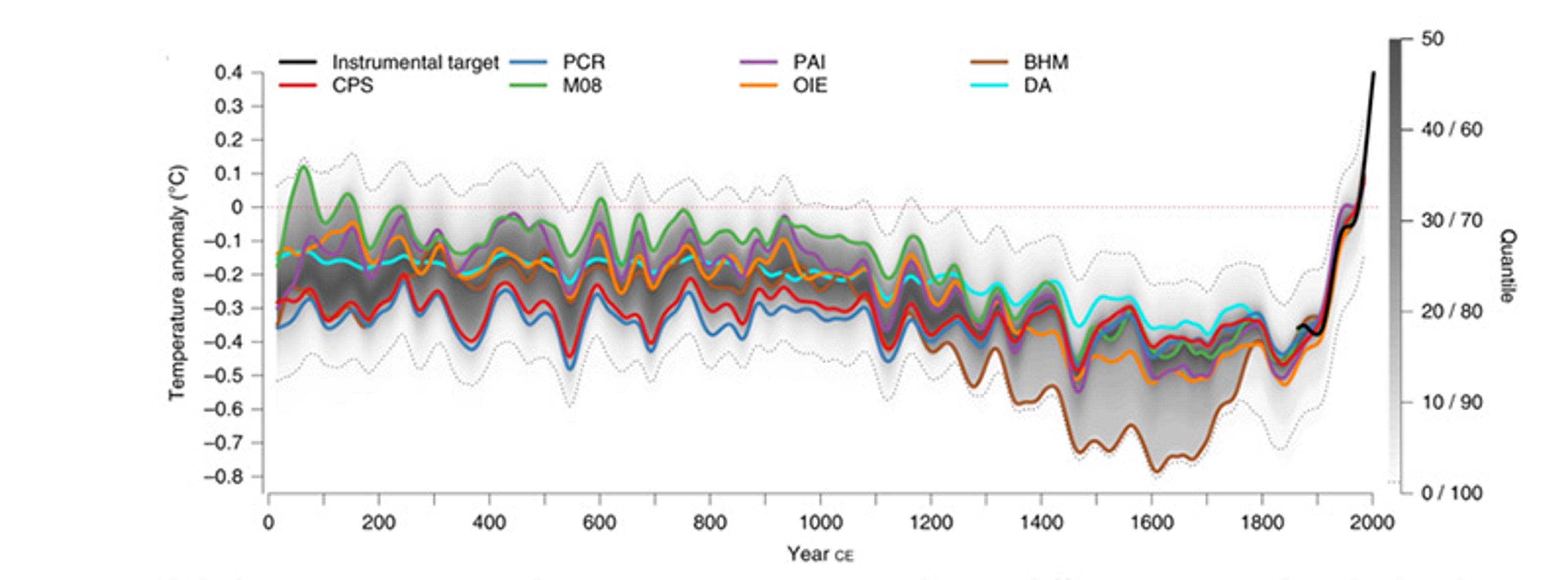
Global temperatures over the past 2,000 years, according to different statistical methods. The black line represents modern warming, as measured by meteorological instruments (such as thermometers in weather stations)
These cooling waves are together called the ‘Little Ice Age’, which is more than a bit of a misnomer. Global cooling in even the chilliest decades of the 17th and 19th centuries – the coldest of the period – probably did not exceed 0.5 degrees Celsius. Unlike today’s warming, cooling reached different places at different times, with more or less severity, and hot years could interrupt even the coldest decades. Glaciers did expand out of many mountain ranges, but this was not an ‘Ice Age’.
Nor was it ‘little’. Temperature anomalies were probably longer-lasting and more severe than any had been for millennia, especially in the Northern Hemisphere. They brought short-term changes in ocean currents and wind patterns that repeatedly drenched some regions in torrential rain, or afflicted others with landmark droughts. For those who lived through it, the Little Ice Age was no trivial matter.
Archaeologists and historians have long argued that many societies were woefully unprepared for the cooling of the Little Ice Age, and therefore suffered tremendous losses. When the Little Ice Age first chilled Greenland, for example, the sedentary agricultural practices that Vikings brought with them from Europe were no longer viable. Yet the Vikings, they supposed, stubbornly adhered to those practices, victims of cultural assumptions that they could not abandon. As temperatures continued to drop in the 14th and 15th centuries, the Viking settlements disappeared.
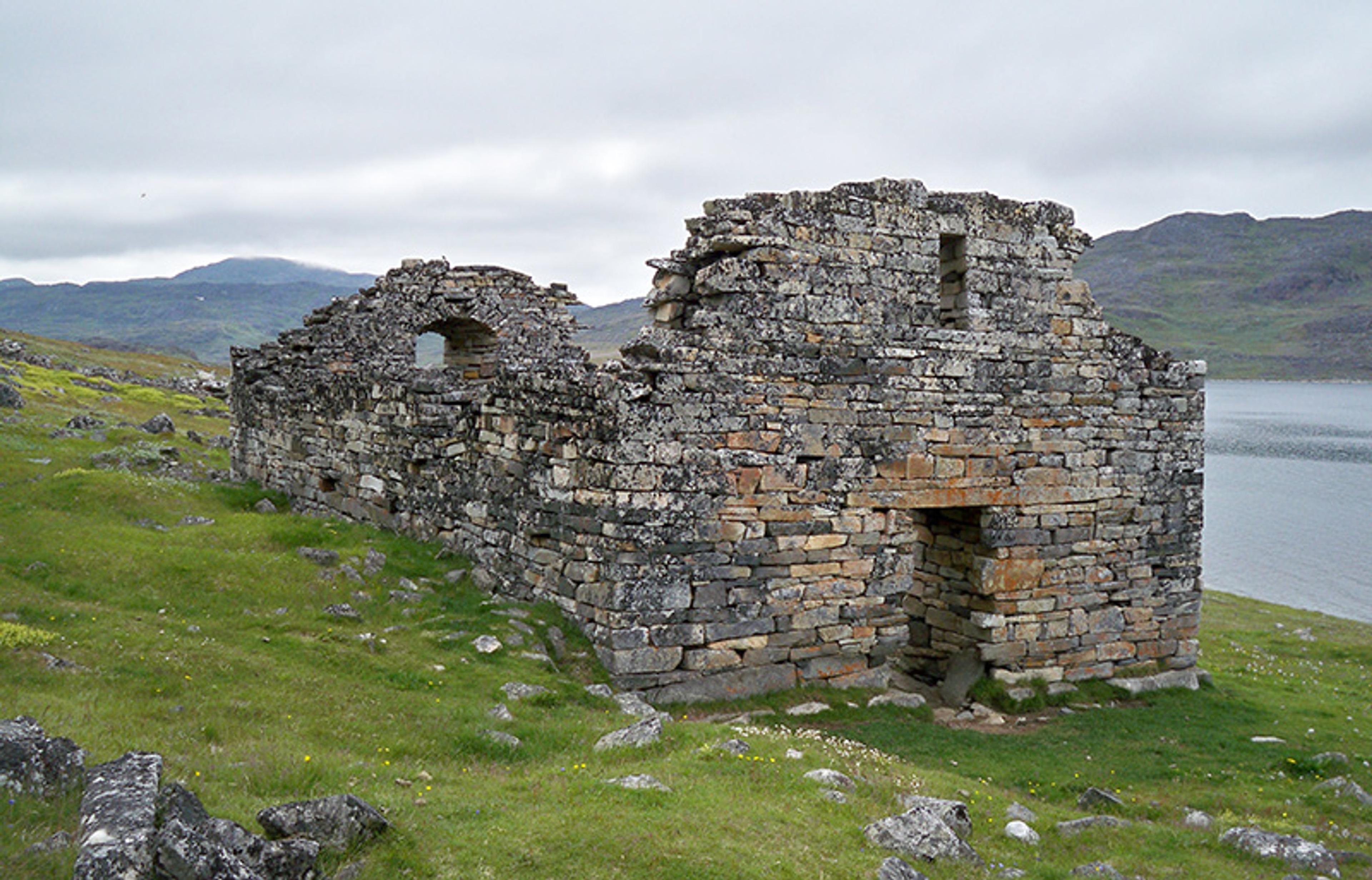
The remains of Hvalsey Church, the location of the last written record of the Greenlandic Vikings. Photo courtesy Wikipedia
At around the same time, waves of bubonic plague swept across Eurasia, killing tens of millions. Some scholars have argued that torrential rains associated with the onset of a newly unstable European climate in the early 14th century ruined harvests and spurred the rise of disease among cattle, leading to a Great Famine that killed perhaps 10 per cent of the continent’s population. Malnutrition in children can permanently weaken immune systems, and those who were children during the Great Famine were especially vulnerable to the later arrival of the plague. Others claim that precipitation extremes provoked by the onset of a cool but unstable climate drove booms and busts in the population of rodent vectors for the plague. When rodents in central Asia multiplied, fleas that carried plague did too; when they declined, fleas overcrowded on surviving rodents fled in desperation to new hosts: humans living nearby. After such migrations, waves of plague slowly travelled west towards Europe.
Researchers once knew little about the effects of the Little Ice outside of Europe, but no longer. It now seems, for example, that the frigid decades of the 15th century brought unseasonal frost across Mesoamerica, repeatedly ruining maize harvests in the Aztec empire. Food shortages provoked famine and, if surviving accounts can be believed, even cannibalism, weakening the empire just before the arrival of European ships and soldiers.
Across Europe and North America, the 17th century was the coldest of the Little Ice Age. Researchers have argued that, by then, the world’s great empires had grown vulnerable to even the slightest shift in environmental conditions. Populations that expanded in the warmer decades of the 16th century increasingly depended on crops grown on marginally productive farmland. Imperial governments financed ever-more expensive wars using surpluses siphoned from far-flung hinterlands. With rural areas already stretched to breaking point, temperature and precipitation extremes provoked calamitous food shortages. Famines led to widespread starvation, migration and epidemics, which in turn kindled rebellions, civil wars and conflict between states. According to the historian Geoffrey Parker, this ‘fatal synergy’ between climatic cooling, starvation, disease and conflict culminated in a ‘global crisis’ that killed perhaps a third of the world’s population.
Mutually reinforcing environmental trends exacerbated already-dangerous military and economic pressures
Over much of the world, the Little Ice Age reached its coldest point in the early 19th century, with the chilliest decade of all following in the wake of a massive volcanic eruption in 1809 and the cataclysmic detonation of Mount Tambora in Indonesia in 1815. Researchers have traced how summer frost ruined crops across China, especially in the province of Yunnan, where millions starved to death. Cooling also weakened the temperature differential between land and water, which delayed the vital rains of the Indian monsoon and thereby unleashed famine and epidemics across India.

The caldera left behind by the Tambora eruption in 1815, which blew away much of the mountain. Photo courtesy Wikipedia
Yet a new wave of research is revealing previously overlooked examples of creativity and adaptability even in communities that suffered most as Earth’s climate changed. Let us revisit, for example, the plight of the Vikings in medieval Greenland. Archaeologists now know that Viking settlers did not simply bring the same, inflexible set of subsistence strategies to every environment they colonised. In Greenland, for instance, Viking hunters learned to travel for hundreds of miles to kill walrus and harvest their ivory and hides. Sailors in longboats would bring these commodities to Europe in exchange for iron and other supplies that were difficult to obtain in the Arctic.
As the north cooled in the 13th century, Viking colonists developed an innovative irrigation system that increased hay harvests, while reducing their dependence on agriculture by hunting more seals and caribou. At first, Vikings in Greenland therefore adapted well to a cooler climate. Then, in the 14th century, the Thule – ancestors of today’s Inuit and Inupiat peoples – migrated into Greenland and clashed with Vikings over access to vital hunting grounds. European tastes also shifted away from walrus ivory, robbing the Greenlandic Vikings of their main export. It was only in this context – with several crises unfolding at once – that climatic cooling started to unravel the lives and livelihoods of Vikings in Greenland.
The climatic story, too, is more complex than it once seemed. Cooling by itself might not have done in the Vikings. Rather, local and regional increases in the frequency and severity of storms; the extent and persistence of sea ice; and the variability and unpredictability of weather together disrupted Viking trade, hunting activities and agriculture. It was only when faced with all these challenges that the Vikings eventually disappeared from Greenland.
It now seems that our ancestors were more than hapless victims in the face of climate change. In Greenland, cooling did not simply cause the destruction of stubborn agriculturalists, as scholars once believed. Rather, it was part of shifting and mutually reinforcing environmental trends that exacerbated already-dangerous military and economic pressures. Caught in that complex vice, the Vikings endured until they no longer could.
Let us return to the Dutch Republic, a little country that has left behind a voluminous record of its travails in the frigid 17th century. At first glance it, too, was swept up in the global crisis. Scarcely a year went by that the Republic was not at war, if not in Europe then in the far-flung reaches of an embattled empire. Simmering tensions between different religious and political factions repeatedly erupted in mob violence and even, briefly, the beginnings of civil war. Between invasion and revolts, the existence of the Republic repeatedly looked uncertain. Taxation, public debt and the cost of labour soared over the course of the 17th century, while previously competitive industries, from textile manufacturing to brewing, declined. Powerful storms, a feature of the Little Ice Age in northwestern Europe, repeatedly broke through Dutch dikes and sluices, drowning thousands. Small wonder that researchers have grouped the Republic with other examples of climate-caused crisis in the 17th century.
Yet take a step back, and the Dutch experience of climate change seems completely different. The Dutch economy boomed for much of the late-16th and 17th centuries, so that per-capita wealth was higher in the Republic than it was anywhere else in the world. Even in the face of economic headwinds later in the 17th century, the economy was flexible enough to transform itself, rather than decline. The Republic’s population soared, too, and urbanisation in the coastal provinces had little parallel until the 20th century. Infrastructure rapidly improved, and commerce expanded globally until the Dutch became the world’s leading trading nation. The Dutch army and especially its navy won battles and wars against far more populous nations, and the Republic became, for a while, Europe’s leading maritime power. Culture and science underwent such a remarkable efflorescence that the 17th century is still remembered by some as the Dutch ‘Golden Age’.
To some extent, the Republic’s successes were partly a product of Dutch resilience to the Little Ice Age. People in coastal cities, for example, had diverse diets and could therefore cope with shortages in a particular food. Urban charities provided for the poor, who were particularly vulnerable to harvest failures in other countries. Climate change also seems to have benefitted the Dutch. Much of the Republic’s economic dynamism stemmed from activities at sea, where complex changes in patterns of prevailing wind mattered more than cooling. These changes shortened Dutch commercial voyages and often helped Dutch war fleets more effectively harness the wind when sailing into battle.
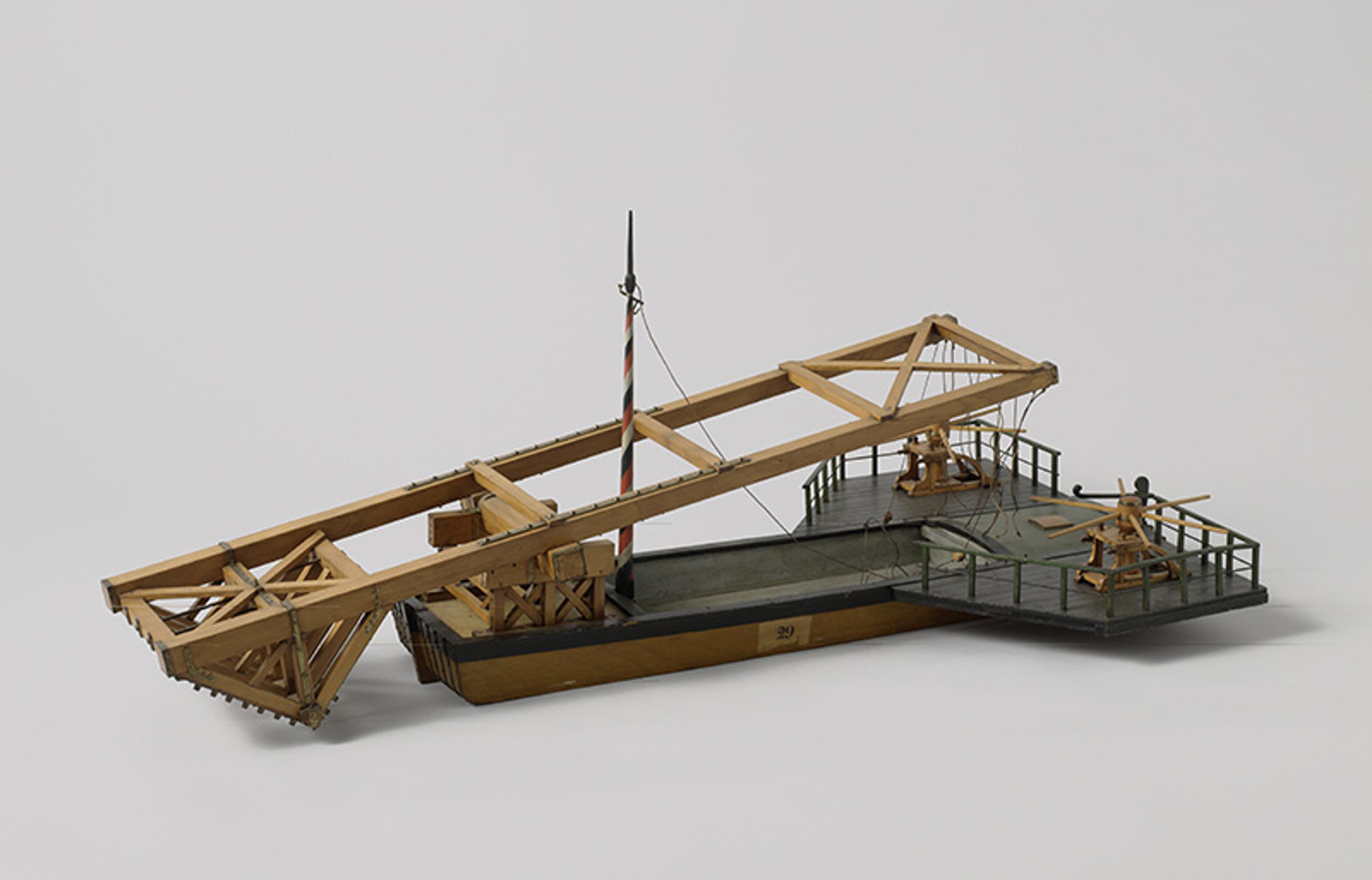
A Dutch icebreaker, designed to break harbour ice into pieces for use in cellars. Courtesy the Rijksmuseum, Amsterdam
Climate change did pose severe challenges for the Dutch and, when it did, the Dutch often adapted creatively. When storms sparked a series of urban fires across Europe, for example, Dutch inventors developed and then exported new firefighting technologies and practices. When winter ice choked harbours and halted traffic on essential canals, the Dutch invented skates and refined icebreakers. Merchants set up fairs on the ice that attracted thousands from afar, and pioneered insurance policies that protected them from the risks of storms at sea.
Both Europe and the Americas now seem like hotbeds of resilience and adaptation to climate change
Other examples of societies that thrived during the Little Ice Age are now coming into focus. In the Americas, Indigenous communities appear to have been especially inventive and resilient in the face of the Little Ice Age. In the 16th and 17th centuries, for example, Neutral Iroquoians in Northeastern America adapted to a cooling climate by shifting away from sedentary agriculture, prioritising hunting and building smaller settlements. Neighbouring Iroquioan communities, by contrast, migrated and depended on decentralised social networks to share increasingly scarce resources. Some Algonquian societies adopted the opposite approach, abandoning egalitarian social orders in order to more effectively defend cornfields from rival communities. Wabanaki raiders used an Indigenous technology, the snowshoe, to outmanoeuvre English soldiers. And in the American Southwest, Mojave peoples learned how to store and transport food as effectively as any Dutch merchant.
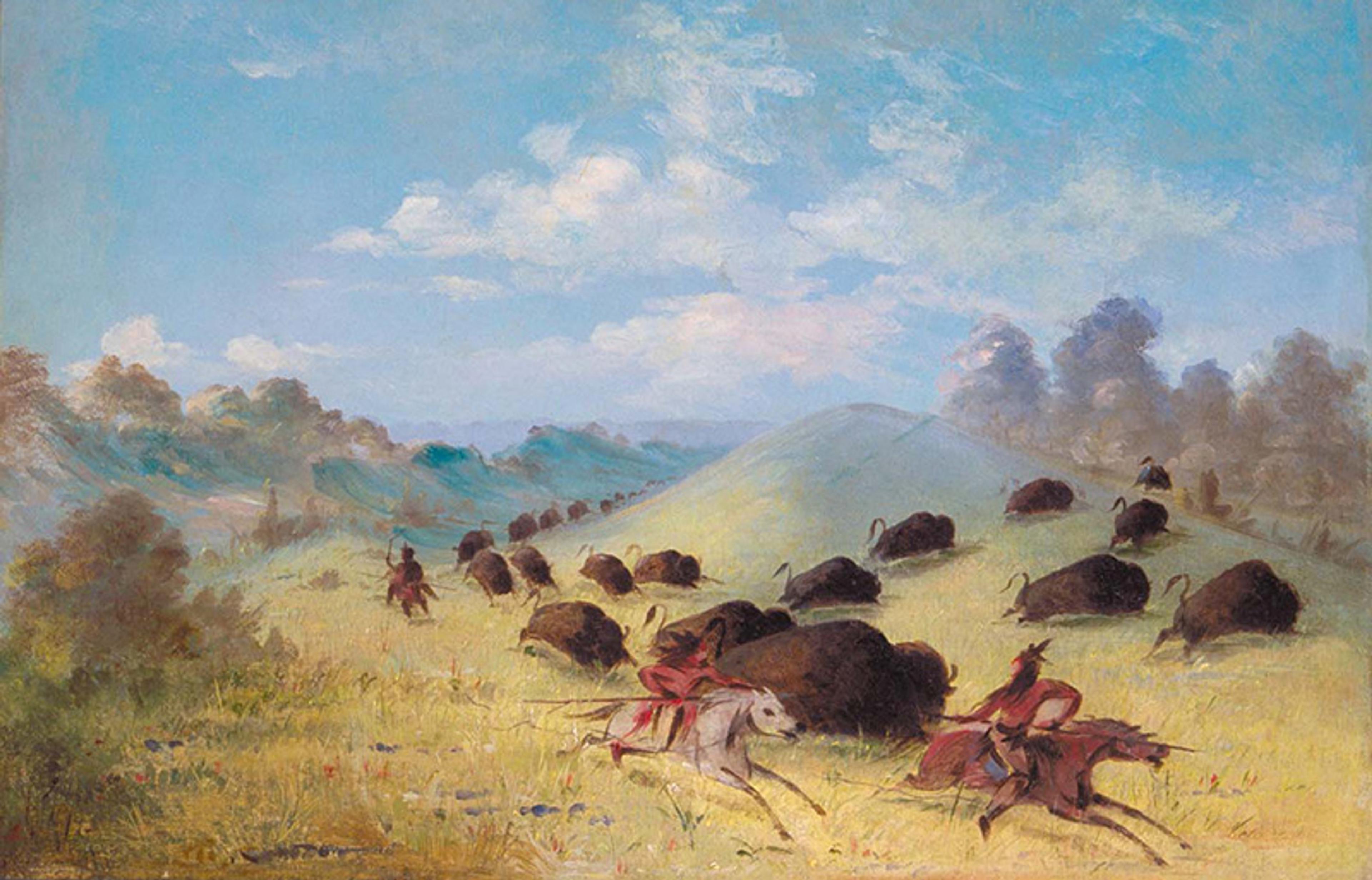
Comanche Indians Chasing Buffalo with Lances and Bows (1846-1848), by George Catlin. Courtesy Wikipedia
Like the Dutch Republic, the vast Comanche polity that surged to prominence across the 18th-century Great Plains seems both to have benefitted from and adapted to the cooling of the Little Ice Age. Beginning in the 16th century, chilly, rainy weather encouraged bison to migrate and then expand rapidly across the plains. While many Indigenous societies moved to take advantage, the Comanche soon dominated them by combining guns and horses for both hunting and raiding. By exploiting the vast and growing bison herds, the Comanche of the 18th century gained the wealth to raid or trade with societies across the entire Great Plains region. When frost or drought provoked food shortages in one community, another far away usually experienced different weather and therefore had enough supplies to make up the shortfall.
Europe and the Americas: both continents once looked like epicentres of a global climate crisis. Yet increasingly, both now seem like hotbeds not only of vulnerability to climate change, but also of resilience and adaptation. Different communities and even individuals within societies experienced climate change very differently, and there does not seem to have been a common, dismal fate shared by all who faced the coldest centuries of the Little Ice Age.
Our tendency in both popular media and academia to tell simplistic climate-change disaster stories has not served us well, either in understanding the past or in preparing for the future. Popular misconceptions that humanity is doomed – that we are, as the US presidential candidate Andrew Yang put it recently, ‘10 years too late’ – threaten to discourage the very action that could still limit anthropogenic climate change to manageable levels. Far less defensible assumptions that climate change has happened before and is therefore nothing to worry about – ahistorical nonsense often fronted by those who once denied the very existence of human-caused warming – pose even greater obstacles to urgent action. It is crucial that we expand the space between these harmful extremes. Writing more nuanced histories of past climate change is one way to do it.
Those histories cannot reveal how exactly we will cope with extreme warming. The environmental challenges we face are far greater than those overcome by the Dutch or Comanche, but our means of understanding and confronting them are greater, too. Yet the past can reveal deep truths – parables – that might otherwise have remained hidden. It suggests, for example, that relatively small environmental shocks can provoke outsized human responses, especially in times when economic or political systems are strained to the breaking point. Yet it also reveals that climate change does not simply determine human outcomes, as some have assumed.
The past tells us that when climatic trends make it impossible to live in the same city, grow food in the same way or continue existing economic relationships, the result for a society is not invariably crisis and collapse. Individuals, communities and societies can respond in surprising ways, and crisis – if it does come – could provoke some of the most productive innovations of all. Those responses, in turn, yield still more transformations within evolving societies. If that was true in the past, it is even more true today, as seismic political and cultural changes coincide with the breakneck development and democratisation of artificial intelligence, synthetic biology and other revolutionary technologies.
Most attempts to estimate the economic or geopolitical impacts of future warming therefore involve little more than educated guesswork. The future is hard to predict – perhaps harder than it ever was – and both collapse and prosperity seem possible in the century to come. So let us approach the future with open minds. Rather than resign ourselves to disaster, let us work hard to implement radical policies – such as the Green New Deal – that go beyond simply preserving what we have now, and instead promise a genuinely better world for our children.
